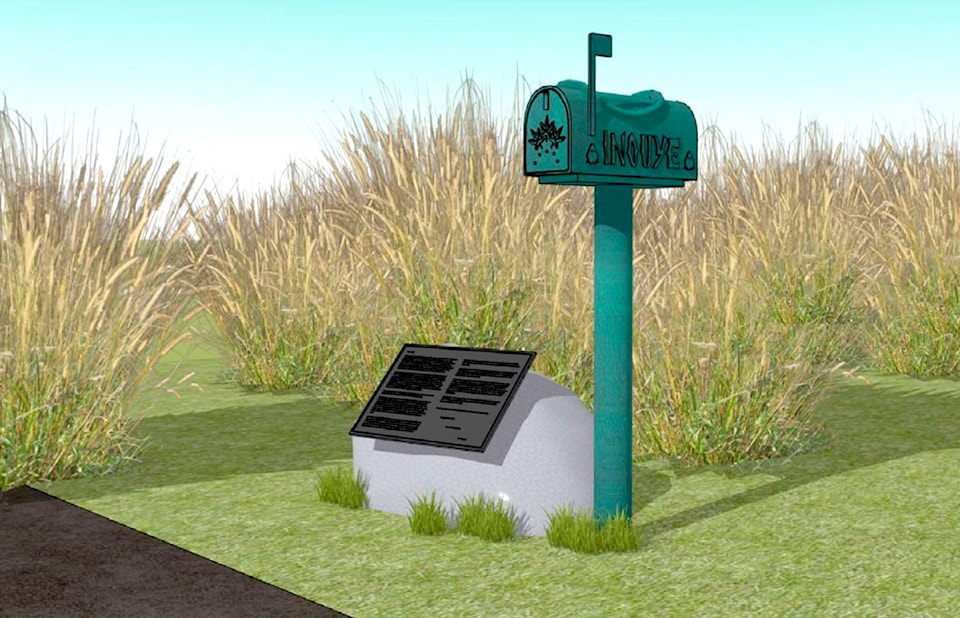Two parks in Surrey will be home to heritage features and integrated artworks celebrating Strawberry Hill’s Early Japanese-Canadians.
Surrey council has authorized staff to contract Ontario-based artist Kellen Hatanaka to complete sculptures for installation at R.A. Nicholson Park (site of “Stone Fruit”) and also Inouye Park (a cast bronze sculpture of a rural mailbox).
Both parks are in Newton, where early Japanese-Canadian farmers and community builders lived and worked, in the area known as Strawberry Hill.
Selected after an open artist call, Hatanaka’s heritage art works are funded by Japanese Canadian Legacies Society (JCLS), incorporated in 2022 following a $100-million commitment from the B.C. government to support the “historical wrongs framework” recommended by the National Association of Japanese Canadians’ BC Redress Project.
At R.A. Nicholson Park (12140 75A Ave.), Kellen’s “Stone Fruit” heritage art will consist of a cast bronze strawberry box and stone strawberries arranged across the grass.
“The work references the legacy of Japanese Canadian farmers who worked the land in this neighbourhood developing a thriving berry growing community,” according to a corporate report authored by Laurie Cavan, Surrey’s general manager of Parks, Recreation & Culture.
“The spilled container represents the injustice of internment; the losses experienced by the community, and the way people were forcibly removed. One can imagine the berries being knocked over in a panic as families tried their best to prepare for this traumatic situation. The work provides an accessible entry point into a difficult history, integrating seamlessly into the park environment.”

Rendering of artist Kellen Hatanaka’s “classic rural mailbox” sculpture approved for Inouye Park in Surrey. Image: surrey.ca
At Inouye Park, art representing “a classic, rural mailbox” will be installed. “The mailbox is an instantly recognizable symbol of rural and farm life, as well as the Japanese Canadian farming community that existed in this area. It also relates to the idea of home and land ownership. Furthermore, this feature informs residents of Mr. Inouye’s fight to reclaim his property through the writing of 80 letters to the Federal Government. Accompanying this sculpture will be a boulder and plaque with the text from one of Mr. Inouye’s letters.”
Dedicated in 2022, Inouye Park is a 44-acre “natural area park” located at 8985 Queen Mary Blvd., south of the original Inouye farm property.
In February 2024, a delegation from the JCLS presented a heritage sites funding opportunity (part of a larger funding framework) to the Surrey Heritage Advisory Commission (SHAC), which then recommended that City of Surrey staff apply for funding from the JCLS for a project “that connects residents to the legacy of Surrey’s early Japanese Canadians and confronts the injustice of their uprooting, dispossession, and internment,” according to a July 24 report approved by the city council.
“At the time of internment in 1942, Surrey’s Japanese Canadian population was about 500 residents.”
A project application dubbed “Strawberry Hill’s Early Japanese Canadians” was drawn up, and funding of $400,000 was secured from the JCLS.
SHAC “enthusiastically endorsed” Kellen’s design proposal at a meeting on July 9, 2025, according to Cavan’s report to city council.
The total cost for the heritage features and integrated artworks is $280,000, and the JCLS will cover “100% of the project’s hard costs, with the City committing in-kind contributions valued at $58,000,” Cavan notes.
“The heritage features will be further complemented with additional heritage research, interpretive signage, community consultation, and a community celebration in 2026.”


AloJapan.com